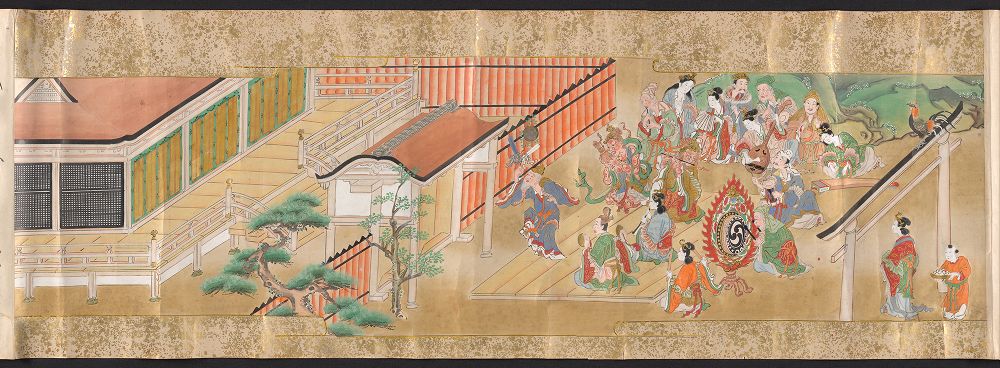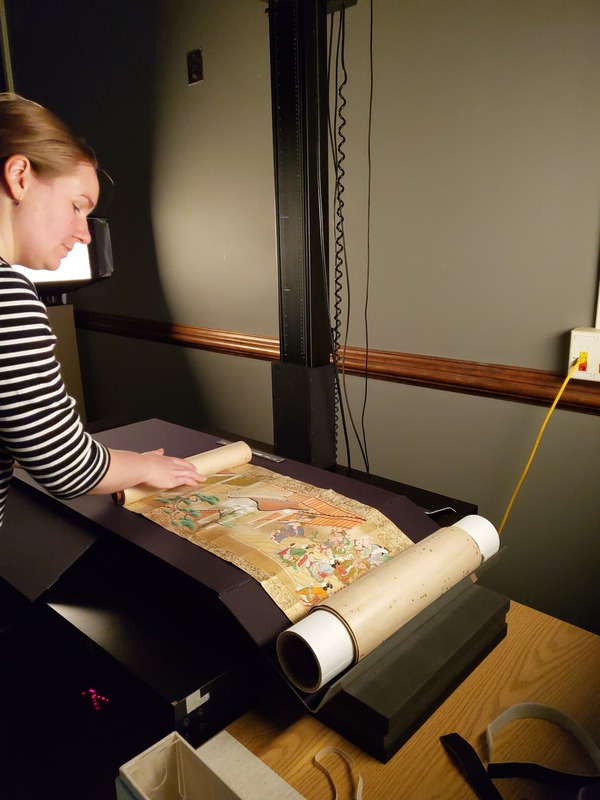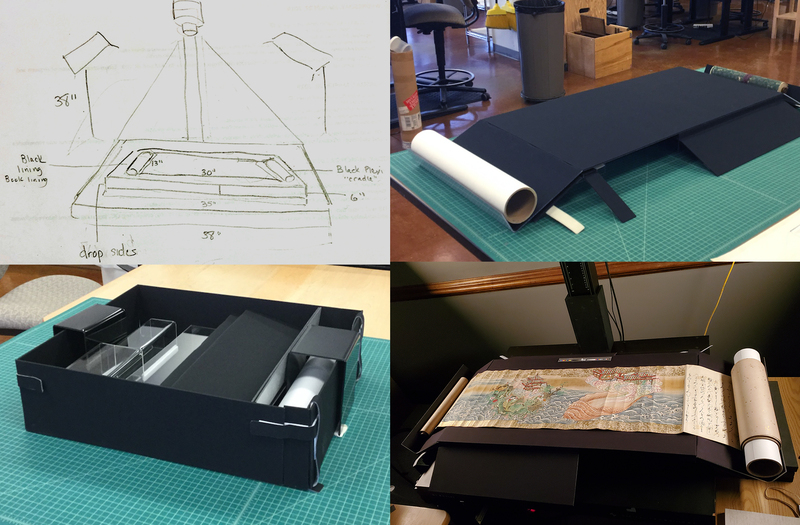- Exhibits
- Digitizing the Hōrai no makimono Japanese Scroll
Digitizing the Hōrai no makimono Japanese Scroll
Last year, Digitization Services teamed up with Conservation and Professor Steve Witt to digitize the Hōrai no makimono Japanese Scroll, held by the Rare Book & Manuscript Library at Urbana-Champaign. The nearly 10 meter-long scroll presented a wide range of challenges given its length, condition and format. This scroll was the first Digitization Services worked with and required collaboration with Conservation to facilitate safe care and handling during digitization.
Rachael Johns, Marco Valladares Perez and Angela Waarala conceptualized the process, identifying the challenges the scroll presented. Rachael and Marco designed the cradle which supported the scroll during digitization, adjusting and testing the holders’ functionality. Angela Waarala, Tricia Lampron and Steve Witt worked on the display and metadata for library’s digital repository, identifying individual views of the scroll. Steve and Tricia identified specific elements to enhance its accessibility. Steve worked with scholars dividing the scroll into frames, pairing the paintings with the appropriate text. This was a truly collaborative process. The Horai no makimono Japanese scroll is accessible in the Digital Library and is digitally preserved the library's digital preservation repository.
Rachael Johns - Digital Imaging Specialist II - Development of cradle and digitization process
When Marco invited me to the Conservation Lab to check out the cradle he designed and train me to use it with the scroll, I was excited. Marco was charged with engineering a box that, if shooting took longer than a day, would allow the Rare Book & Manuscript Library staff to safely transport the scroll to the vault and back while keeping intact the section of scroll open for digitization.
It was special to get one-on-one training in handling one specific item. I wanted to be sure to ask lots of questions while I was with a conservator before my work began in the digitization lab. Marco was patient and clear, teaching me how to remove the scroll from its housing and unroll it in segments. The techniques were different than I often use for flat materials. Getting experience handling the scroll with Marco’s guidance was helpful. Special collections materials are sometimes extremely fragile, but thankfully the scroll was cooperative, devoid of brittle break-offs or other potentially damaging traits.
The experience in Conservation Lab gave me confidence while handling the scroll. Marco’s tools designed for holding the scroll in place, his solution to lift the box with risers to eliminate shadows and innovation of the drop sides to hold the wound scroll ends were delightful. The joy of working with Marco on this was one of creative curiosity and I appreciated the dynamic collaboration he welcomed. I had the opportunity to ask questions about the design. I posed many “what if?” and “would it be possible?” questions. Marco kindly entertained my curiosities! I also noticed a visible seam when the box was expanded and imagined it could add extra post processing work to clean up the background of each image. I asked about lowering the support for the scroll ends to eliminate shadows on the part of the scroll being photographed. Adaptable background surfaces for the box were an important consideration for future use of the cradle box to prevent issues, such as moiré, or when digitizing translucent scrolls that might need different surfaces. This change is as simple as trimming a new surface to the right dimensions.
From the first sketch to implementation, digitization, preservation and access
In the early stages of this project, discussions focused on the physical challenges involved in digitizing the scroll. Just as important was the need for a viewer allowing users to access the scroll digitally. The challenge - provide access to high resolution details of the object, scroll freely left and right and view panes of text with paintings individually. The translation of a physical object like a scroll into a digital object mimicking the experience one has while sitting in front of the scroll, is a familiar challenge while digitizing special collections. A few years ago, the Digital Library was launched, which hosts many of the library's locally digitized special collections, and utilizes the available IIIF viewer (International Image Interoperability). Unencumbered access with proper navigation and metadata brought this beyond the vault to anyone who wants to interact with it.



